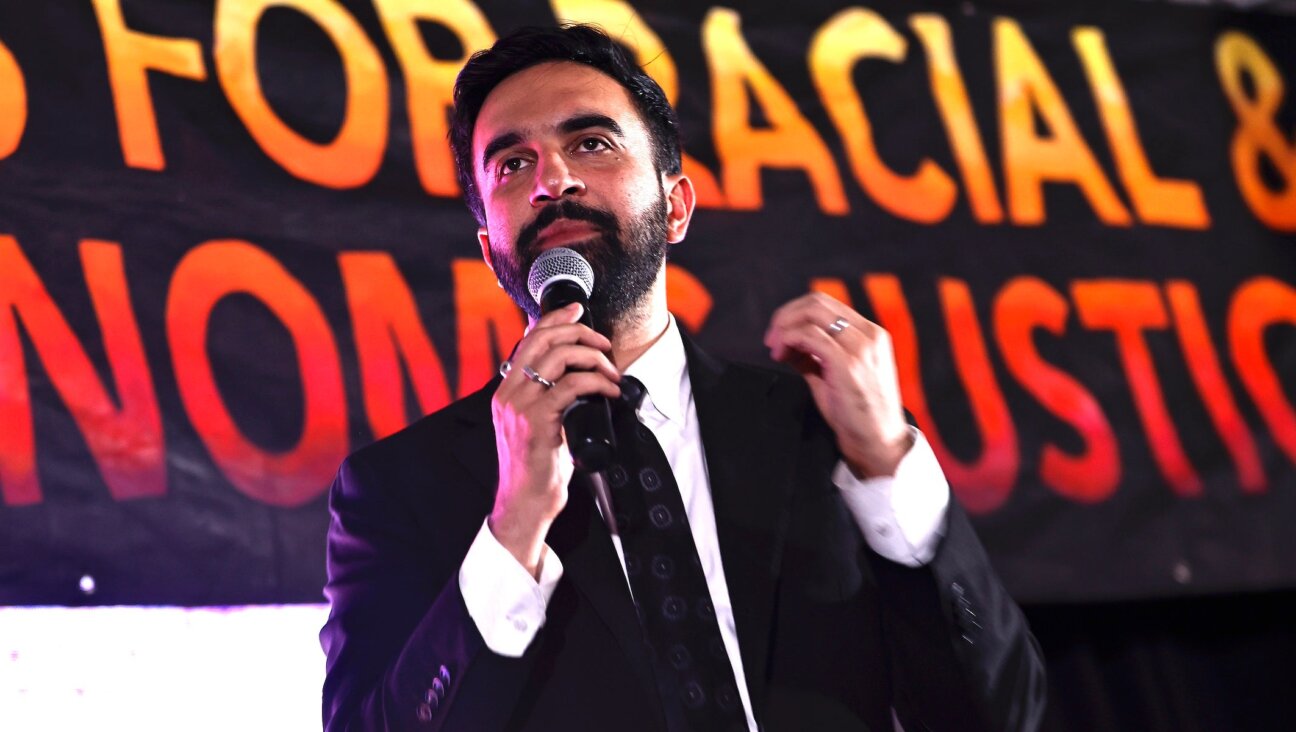Jewish Woman’s Asylum Request Brings Attention to Anti-Semitism in Sweden

Annika Hernroth-Rothstein (in white coat) at a pro-Israel demonstration on Nov. 22, 2012 in Stockholm. Image by JTA
With an asylum application to her own homeland, Annika Hernroth-Rothstein was hoping to draw attention to the problem of anti-Semitism in Sweden.
Hernroth-Rothstein acknowledges the bid is “absurd” – but it’s working, having garnered international media coverage and stirring debate.
“EU statutes provide that asylum be granted to persons with ‘well-founded reasons to fear persecution due to race; nationality; religious or political beliefs; gender; sexual orientation; or affiliation to a particular social group,’ ” she wrote in Nov. 17 essay in Mosaic Magazine, a U.S.-based Jewish online publication where she first announced her bid. “Jews in Sweden meet these criteria, and should be eligible for the same protection and support extended to non-natives.”
Hernroth-Rothstein’s media stunt has garnered coverage in leading Swedish media outlets and Jewish publications around the world. Yet as of Wednesday, one party seemed oblivious to her request: the Swedish Migration Board, the government body responsible for processing the applications of asylum seekers.
“I haven’t heard of any case like that,” Katarzyna Zebrowska, the board’s press officer, told JTA. “She may have left a form behind at our office, but that doesn’t make her an applicant.”
Zebrowska explained that the board cannot process applications by Swedish nationals under Swedish law, which defines asylum as a residence permit granted to foreign refugees.
Hernroth-Rothstein, 32, a well-known activist for Israel and against anti-Semitism, acknowledged to JTA that her request – which she said she delivered in person to the board’s offices – in all likelihood would not be processed as an official application.
In explaining her action, Hernroth-Rothstein has cited initiatives to further limit circumcision in Sweden (only licensed circumcisers may perform the procedure, though the country’s Jewish community finds the arrangement acceptable); Sweden’s ban on animal slaughter without stunning, which effectively prohibits kosher slaughter; and anti-Semitic crimes and harassment.
“I have two sons, and I have to choose between giving them a strong, positive Jewish identity and keeping them safe, and I don’t see that as a choice that we should have to make,” she said in an interview with Sweden Radio.
A spokesman for the Council of Jewish Communities in Sweden told JTA that the organization had no comment on Hernroth-Rothstein’s asylum request. But another Swedish Jewish activist criticized the move.
“I think it’s an overreaction that is also exploitative of the real need of asylum seekers in this country,” said Marc Harris, a law student who is a former president of Limmud Stockholm and former chairman of the Synagogue Committee at Stockholm’s Great Synagogue.“We need to be vigilant of the real threat of anti-Semitism and we can’t exaggerate it.”
Sweden, he added, does have an anti-Semitism problem, “but it is not swept under the carpet; the media are already very aware of it. We need to watch out we’re not just crying wolf and spreading fear.”
There are indications that many Swedish Jews already feel afraid.
A recent survey of Jews in nine European countries found that Swedish Jews were the most likely to avoid publicly identifying themselves as Jewish for fear of anti-Semitism. In the survey, published this month by the European Union’s Fundamental Rights Agency, 34 percent of Swedish Jews reported practicing such avoidance. They were followed by France at 29 percent; Belgium, 25 percent; Hungary, 20 percent; and Germany, 14 percent.
Hernroth-Rothstein is intimately familiar with such fears. In Stockholm, she has led “kippah walks” – marches by Jews and non-Jews who don yarmulkes as a protest against anti-Semitism and a sign of solidarity with the country’s Jewish community.
The problem is especially acute for the approximately 1,000 Jews who live in Malmo, a southern Swedish city where about a third of its approximately 300,000 residents are either immigrants from Muslim countries or their children. Malmo last year saw 60 anti-Semitic attacks, which accounted for 40 percent of the anti-Semitic hate crimes documented in Sweden, according to the Swedish National Council for Crime Prevention.
Yet, seen in context, there are worse places to be a Jew in Europe, said Lars M. Andersson, an Upsala University historian who has researched Swedish anti-Semitism and the country’s refugee policy.
“There is definitely a problem with anti-Semitism in Sweden which needs to be addressed,” he said. “However, that problem should not be exaggerated. It is far less acute than in Hungary, for example, where a member of the Jobbik party spoke in parliament in favor of registering all Jews.”
Still, Andersson is supportive of Hernroth-Rothstein’s asylum request.
“I see no problem with the asylum move, which is obviously designed to attract the sort of media attention which will help treat the issue,” he said.
As for Hernroth-Rothstein, she says that if the migration board fails to address her request, then she will file a new one – next time outside the European Union.














